- Hydraulic fracturing
- Hypervelocity impact of meteors
- Earthquake rupture
- THM (Thermal-Hydraulic-Mechanical) reservoir processes
Current Applications of HOSS include:
- Dam stability analysis
- Analysis of reinforcements to historical monuments/buildings
- Induced seismicity
- Bone fracture modeling
- Slope stability (Mining, road infrastructure design)
- Block caving (Mining)
- Experimental rock mechanics
Other potential applications using HOSS include:
Examples of Current Applications
Click on thumbnails for videos and descriptions. Explore the list of publications for more information.
Generalized Shape Dry Particle Interaction
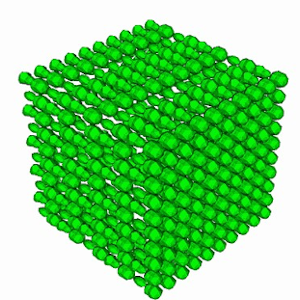
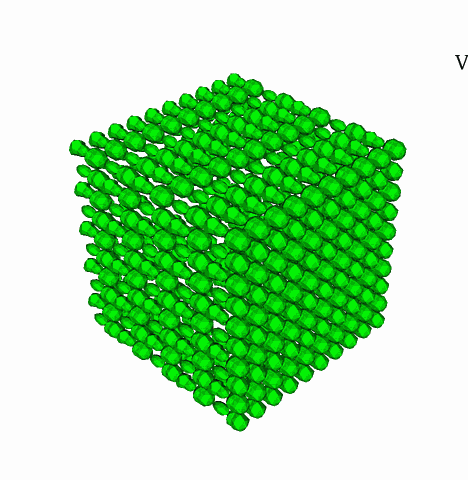
Generalized Shape Dry Particle Interaction
Problem: A performance evaluation of contact detection/interaction of irregular shapes was conducted by applying high velocity boundary conditions to four different general particles contained within a sphereical raster.
Result: Irregular shaped discrete particles are well represented using FDEM, where analysis reveals that both stress waves and resultant displacements of individual particles are accurately and effeciently captured.
Relevance: The result is very similar to those obtained in molecular dynamic simulations of gas inside a containier.
Rougier, E. and A. Munjiza. MRCK_3D contact detection algorithm, in proceedings of Fifth International Conference on Discrete Element Methods, London UK, 2010.
Split Hopkinson Pressure Bar
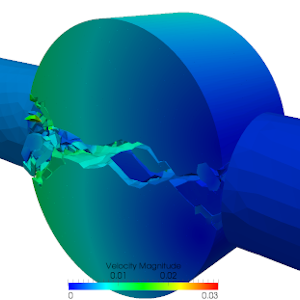

Split Hopkinson Pressure Bar
Problem: Rougier et al. presented a classic example of FDEM laboratory replication for a 3D Split Hopkinson Pressure Bar (SHPB) simulation.
Result: The simulation results show great agreement with the physical experiment in terms of actual replication of breakage and fragmentation. In addition, the simulation also captures relevant experimental measurements such as the evolution of the calculated tensile stress as a function of time.
Relevance: Most computational mechanics simulations pay little attention to capturing the actual “softening” or post-peak failure behavior. However, the exceptional agreement between HOSS’ results and the experimental observations demonstrate that models comprising of full experimental setups concentrating on rock (or other material type) failure can be properly represented in HOSS.
Rougier, E., Knight, E.E., Broome, S.T., Sussman, A.J. & Munjiza, A. 2014. Validation of a three-dimensional Finite-Discrete Element Method using experimental results of the Split Hopkinson Pressure Bar test. Intl. J. of Rock Mechanics and Mining Sciences, 70, 101-108. https://doi.org/10.1016/j.ijrmms.2014.03.011
Hydrofracture
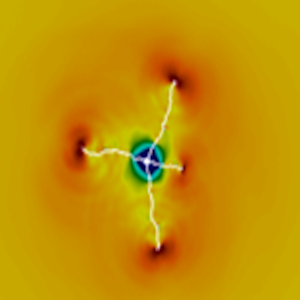

Integrated Solid-Fluid Solver: Hydrofracture
Problem: HOSS-ISF simulations of near-wellbore hydraulic fracturing, with a pressure-time boundary condition specified on the inside face of the half-meter diameter cemented borehole.
Result: A cross-section of the borehole demonstrates that HOSS-ISF can simulate the effects of pre-existing interfaces on the outcome of hydraulic fracture operations.
Relevance: One important aspect to highlight is that in the HOSS-ISF solver the time step size is not dependent on the fracture aperture, as is the case for other FDEM-based solvers. Therefore, this significant improvement introduced by the HOSS-ISF solver allows a four orders of magnitude increase in the computational efficiency.
Lei, Z., Rougier, E., Munjiza, A., Viswanathan, H., & Knight, E.E. Simulation of discrete cracks driven by nearly incompressible fluid via 2D combined finite‐discrete element method. International Journal for Numerical and Analytical Methods in Geomechanics, 43:1724-1743, 2019. https://doi.org/10.1002/nag.2929
Fracture Coalescence
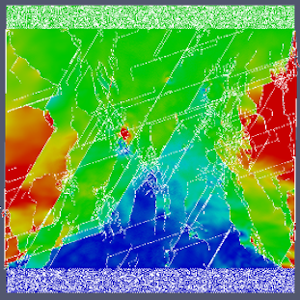

Fracture Coalescence during Uniaxial Compression
Problem: A numerical study of a uniaxial compression test on a 25m x 25m granite block with two embedded in-situ fracture sets is subjected to uniaxial loading imposed by keeping the bottom plate fixed while moving the top plate downwards with constant speed.
Result: As can be seen there is a high degree of complexity and the model appears to perform sufficiently in representing fracture coalescence for large scale problems. This demonstrates that HOSS can be used to analyze complex real-world size fractured rock systems.
Relevance: FDEM is an ideal tool for the numerical simulation of fracture processes. This provides an opportunity to better understand the underlying mechanisms of crack initiation, propagation, and coalescence in geologic materials. For example, when developing mining operations there is a need to understand the behavior of mine pillars under complex loading conditions.
Knight, E.E., Lei, Z., Rougier, E., & Munjiza, A. FDEM Simulation on Fracture Coalescence in Brittle Materials. American Rock Mechanics Association. 2015.
Hypervelocity Bolide Impact
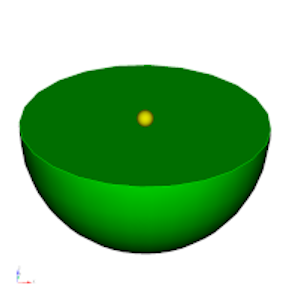

Hypervelocity Bolide Impact
Problem: Recent developments in FDEM made numerical modeling a promising approach to investigate the physics of impacts to provide answers to the outstanding question of seismic efficiency. The simulations shown here consider a 1 km diameter body impacting a 15 km diameter half space, which is based on a hypervelocity verification/validation paper from Pierrazzo et al., 2015.
Result: An animation showing the wave propagation and the material being ejected for the 45 degree angle impact with an initial projectile velocity of 20 km/s is provided. There is good agreement between the results obtained with HOSS and those obtained with other hypervelocity community accepted codes.
Relevance: Traditionally, empirical laws have been used to determine the seismic efficiency of bolide or asteroid impacts. However, empirical laws are not always reliable since they provide seismic efficiency estimates that vary from 10-5 to 10-2.
Knight, E.E., Rougier, E., Lei, z., Euser, B., Chau, V., Boyce, S., Gao, K., Okubo, K., Froment, M. 2020. HOSS: An Implementation of the Combined Finite-Discrete Element Method. Comp. Part. Mech. https://doi.org/10.1007/s40571-020-00349-y
Flyer Plate Dynamics
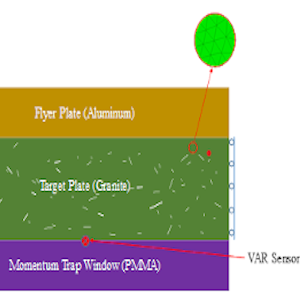

Flyer Plate Dynamics
Problem: HOSS is used to simulate the response of a flyer-plate impact experiment in a Westerly granite sample that contains a randomized set of cracks. The model consists of 3 plates: aluminum flyer plate, granite target plate, and PMMA momentum trap. Within the sample, there are a number of pre-existing cracks each with initial lengths determined by a power law distribution, and randomly distributed orientations.
Result: A Velocity Interferometer System for Any Reflector (VISAR) is used as the interferometer system to measure the free rear surface particle velocity history and in the HOSS model a sensor to record the particle velocity is placed on the back of granite sample. In the model, HOSS accurately reproduces the VISAR plot and captures the spall region and stress peaks observed in flyer plate experiments in granite.
Relevance: The number and the distributions of pre-existing fractures was studied to get better understanding of the effect of structural cracks on the mechanical behavior and the failure path of Westerly granite under high strain rate impact.
Chau, V., Rougier, E., Lei, Z., Knight, E.E., Gao, K., Hunter, A., Srinivasan, G., & Viswanathan, H. Numerical analysis of flyer plate experiments in granite via the combined finite–discrete element method. Computational Particle Mechanics, 2019. https://doi.org/10.1007/s40571-019-00300-w
Mixed-mode Failure
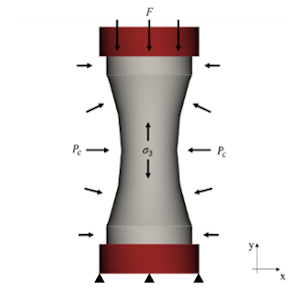
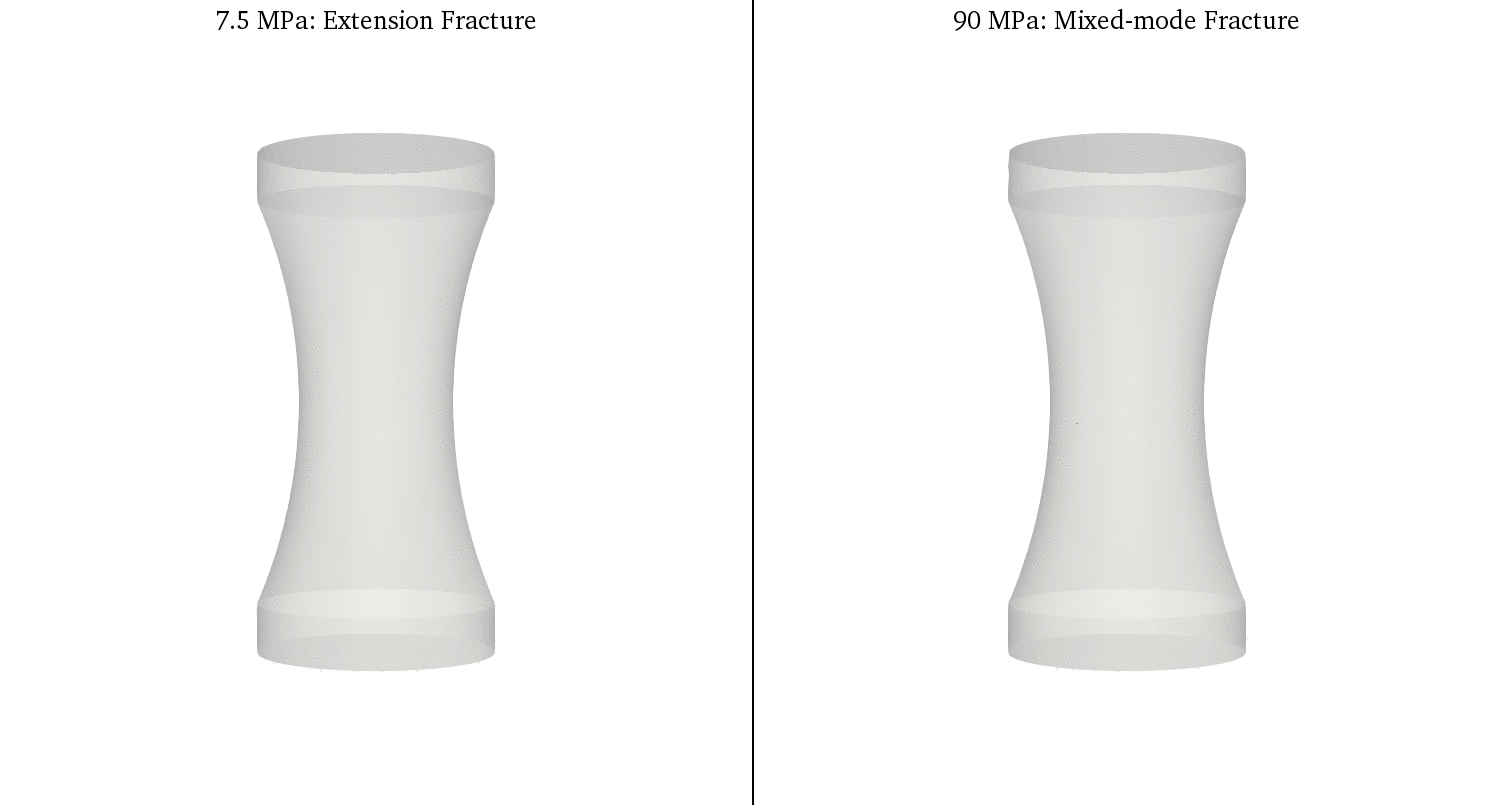
Mixed-mode Failure in Carrara Marble
Problem: The formation of hybrid fractures under mixed tensile and compressive stresses using the HOSS FDEM was investigated. Modeling a series of indirect tension tests with confining pressures that increase from 30 to 150 MPa allows for the development of stress states adequate to generate a spectrum of mixed-mode failure conditions.
Result: The cooler colors show shear fracture domination for initial failure at higher confining pressures near the edge of the specimen. Once the break begins, the axial force acts on the reduced cross-sectional area thus increasing the tensile stress and causing tensile damage in the center of the specimen. A progressive change in fracture orientation as the confining pressure increases matches previous experimental results.
Relevance: This range of tests spans the confined tension region, where the specimen develops a tensile minimum principal stress while the maximum principal stress remains compressive. The corresponding mixed-mode fracture, oriented at an angle less than that of a pure shear fracture, but greater than the angle from an unconfined tensile test, is captured numerically and further validates the hypothesis of a continuous failure envelope from shear to extension fracture.
Boyce, S., Lei, Z., Euser, B. et al. Simulation of mixed-mode fracture using the combined finite–discrete element method. Comp. Part. Mech. 2020. https://doi.org/10.1007/s40571-020-00341-6
Earthquake Dynamic Rupture
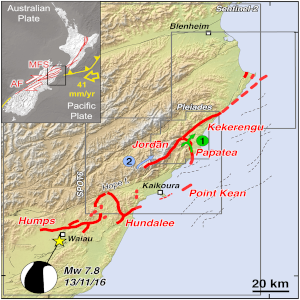
Earthquake Dynamic Rupture
Problem: HOSS was chosen to model the dynamic earthquake rupture of 2016’s Kaikoura earthquake in New Zealand. A new physics-based modeling framework, developed by Okuba et al. 2019, was used to investigate the fundamental mechanisms of coseismic off-fault damage and its effect on rupture dynamics, radiation, and the overall energy budget.
Result: The 2016 Mw 7.8 Kaikoura earthquake in New Zealand was one of the most complex earthquakes ever documented that ruptured at-least 15 faults. High-resolution optical satellite imagery provided distinctive profiles of fault displacement fields. This coupled with the HOSS FDEM numerical approach captured the rupture and activation of off-fault damage, thereby allowing researchers to determine Kaikoura’s most likely rupture scenario.
Relevance: The numercial results when compared to observational mapping confirm that the dynamic earthquake rupture modeling framework can be a mainstay in the earthquake community for analysis of these highly hazardous natural phenomena events.
Klinger, Y., Okubo, K., Vallage, A., Champenois, J., Delorme, A., Rougier, E., Lei, Z., Knight, E.E., Munjiza, A., Satriano, C., Baize, S., Langridge, R., & Bhat, Harsha S. Earthquake Damage Patterns Resolve Complex Rupture Processes. Geophysical Research Letters, 45(19):10,279-10,287, 2018. https://doi.org/10.1029/2018GL078842
Sheard Granular Stick-Slip Behavior
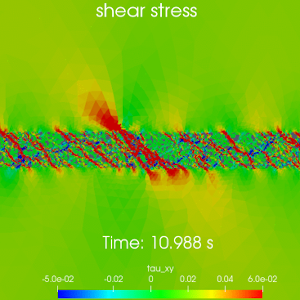

Sheard Granular Stick-Slip Behavior
Problem: Gao et al., 2018, used HOSS to explicitly simulate a 2D sheared granular fault system including both gouge and plate. As the system was sheared, the gouge particles resisted the load via a number of force (or stress) chains. However, at certain points in time, the gouge particles were not able to resist the load in the current configuration, giving way to the occurrence of slip events.
Result: The HOSS simulation results show good agreement with the physical experiment in terms of its capability to capture the stress chain development and the distribution of the size of seismic events. In this case, the force or stress chains are emergent features of a complicated system composed of many different interacting parts.
Relevance: Among the many numerical methods used to describe the evolution of granular systems, more commom DEM methods are incapable of capturing deformation related to stress distributions and elastic wave propagations. The FDEM, on the other hand, provides a natural solution to modeling this system since it not only resolves the interaction between the different parts of the granular system but it also provides a solution for stress wave propagation inside the solid media. This example demonstrates that HOSS is a very powerful tool for the analysis of the gouge material failure and its consequences on earthquake rupture processes.
Gao, K., Euser, B., Rougier, E., Guyer, R.A., Lei, Z., Knight, E.E., Carmeliet, J., & Johnson, P. Modeling of stick‐slip behavior in sheared granular fault gouge using the combined finite‐discrete element method. Journal of Geophysical Research: Solid Earth, 2018, 123(7):5774-5792. https://doi.org/10.1029/2018JB015668
Impact on Unconsolidated Beds
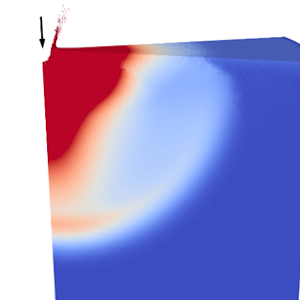
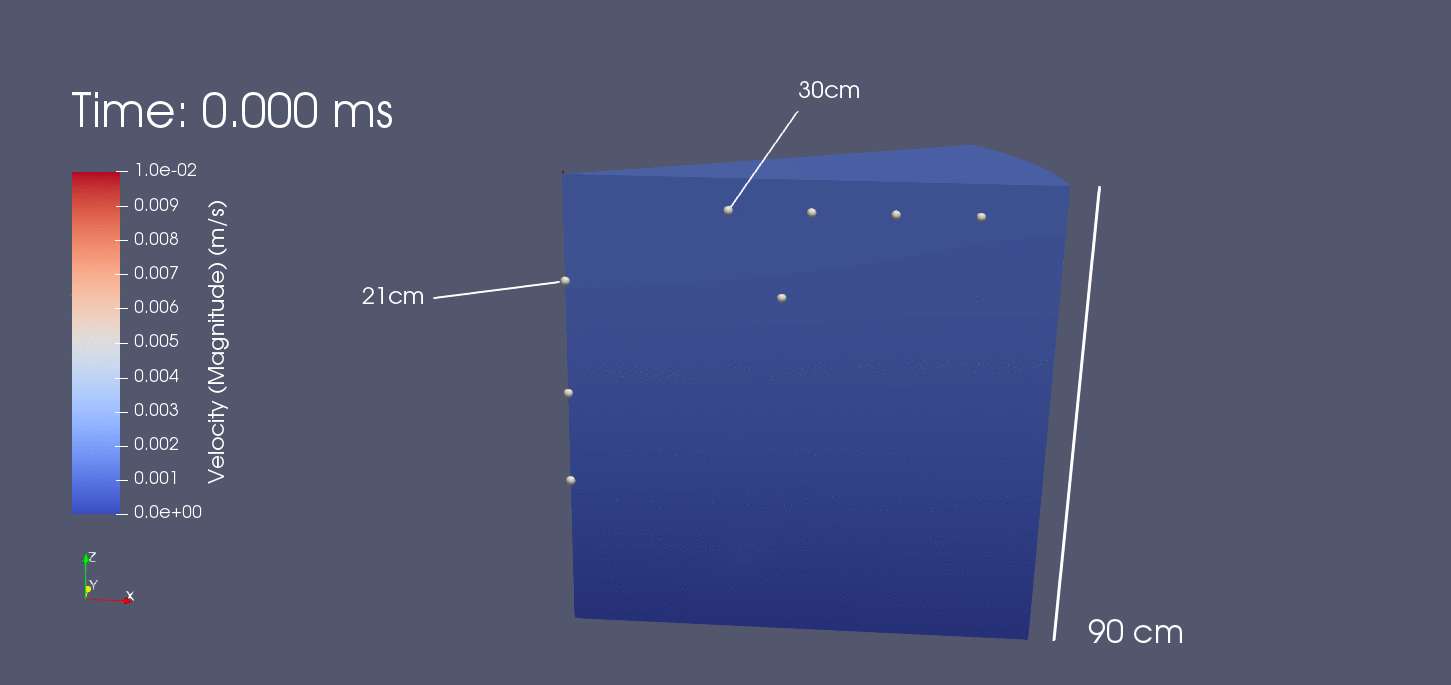
High Velocity Impact on Unconsolidated Beds
Problem: In the context of the NASA InSight mission, which placed the first seismometer on the surface of Mars, interest was focused on a better understanding of seismic sources generated by impacts. HOSS was used to investigate the properties of impacts in a proxy of Mars regolith and to develop and validate a model of this unconsolidated target material under extreme loading.
Result: The case simulated corresponded to a vertical impact with an initial velocity of 0.98 km/s. Since the model is symmetric, and with the aim of reducing the requirements of computational resources, a 30º wedge of the tank was simulated. Very good agreement was obtained between the calculated velocity-time histories for sensors located along a vertical line below the impact point and the observed records.
Relevance: In the FDEM framework the sand granular structure and grain displacements are accounted for by allowing the Lagrangian finite elements to move freely with respect to each other while they interact with each other via frictional contacts.
Froment, M., Rougier, E., Larmat, C., Lei, Z., Euser, B., Kedar, S., Richardson, J.E., Kawamura, T., Lognonné, P. Lagrangian-based simulations of hypervelocity impact experiments on Mars regolith proxy. Journal of Geophysical Research: Solid Earth, 2020. https://doi.org/10.1029/2020GL087393


